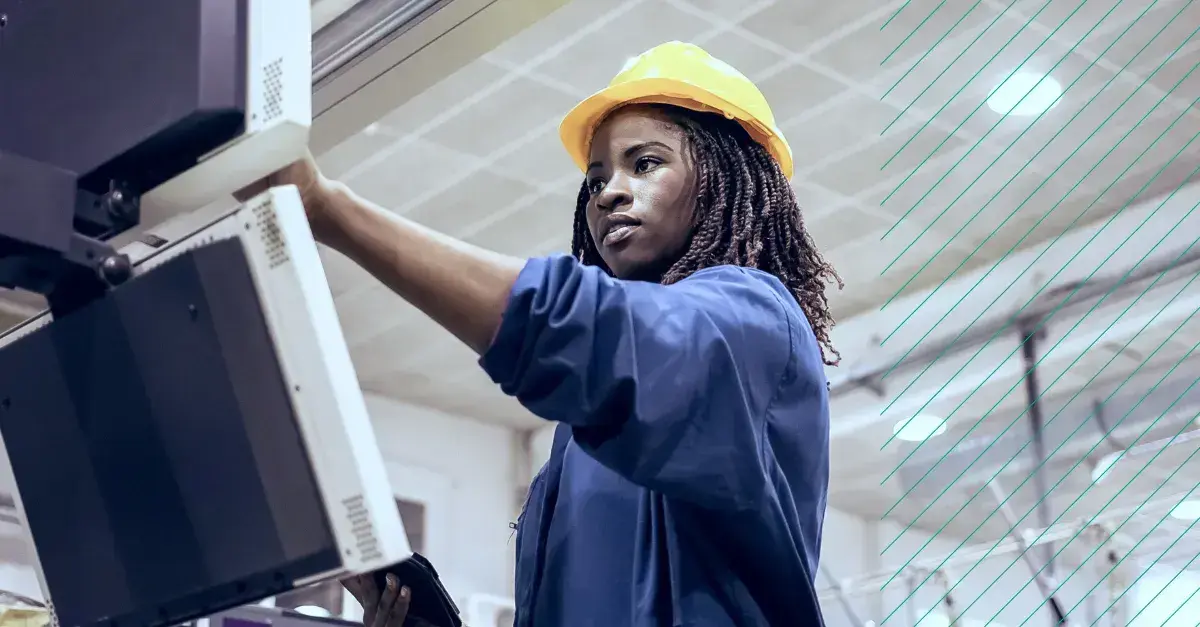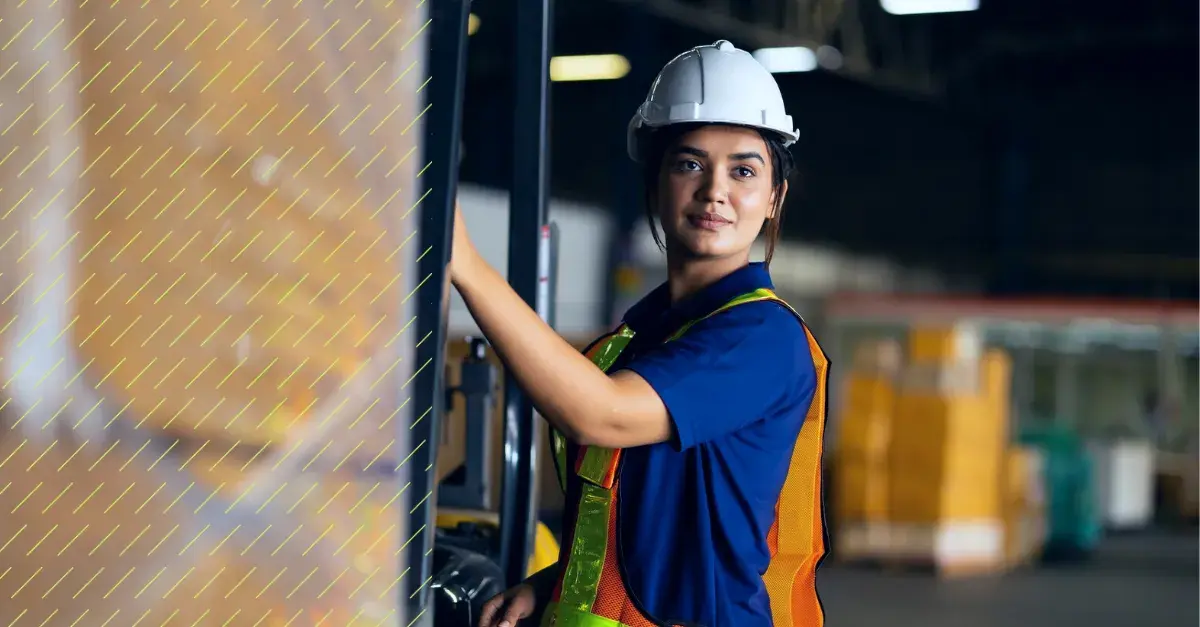

9 Clear Tips: Better Information Design in Manufacturing Training.
Millennials think about information design differently. Check out these 9 tips for delivering knowledge effectively to your deskless workforce and beyond.
It’s a simple fact that our manufacturing workforce will soon be made up almost entirely of Millennials and Gen Zers. In fact, we expect Gen Xers (born between 1961 and 1980) to be almost completely phased out of the global workforce by 2040. Luckily, the text-heavy and complex information design that Gen X grew up with is phasing out as well.
Unfortunately, we still see that there's a lack of user-friendly and clear information design in industrial technology. Complex systems that take years to understand (hello, SAP 👋) that look like they're stuck in 1995 are still the norm.
But first, what is information design?
- Information design =
The art of arranging information in a manner that facilitates easy understanding and retention in the best way possible.
Information design is closely related to instructional design. Both are very important for especially when creating effective training materials.
- Instructional design =
The process of methodically designing, creating, and sharing instructional materials. The goal of instructional design is to offer user-friendly and effective knowledge acquisition to the end-user.
Let's look at how you can improve information design for the younger generation of manufacturing workers.
Nine tips for better information design.
These tips will help you and your teams deliver any type of functional information within the context of a professional work environment.

1. Keep it bite sized.
- We're used to absorbing a large amount of information because of their reliance on a multitude of digital mediums and tools. However, human brains are still only able to process a limited amount of information at a time. This is even more relevant for this generation, as a reliance on technology as a transactive memory becomes more prevalent.
- Recommendation: use a method known as “chunking.” This process describes separating many units of information into a limited number of units or chunks, so that the information is easier to process and remember. A great way to do this is through visually distinct tasks and instructions.
2. Use lists.
- Lists are concise, convenient and completely relatable to how your workforce experiences the world today. From apps to listicles, the Millennial generation is accustomed to processing information in a list format.
- Lists require less decision making and processing time from the user and are especially practical in a time sensitive environment such as the factory floor.
- Recommendation: Make sure to keep lists simple and concise, arrange them in a logical and actionable order, and avoid repeating the same word over and over.
3. Simple words.
- Advertisements, the internet, and a million daily choices mean that the younger generation values getting to the point. Your information design should reflect this fact.
- Recommendation: Simple words and language help clarify tasks and avoid confusion on the shop floor, and we advise manufacturers to take this into consideration when delivering information to the millennial workforce - or anyone working in an environment that values efficiency and clarity.
4. Visualize Data.
- Visual media is processed faster and more effectively than written media. Combine this with the fact that millennials have been raised in an age where data has always been visualized, it makes sense that they would rely on quality data visualizations to process information during their work.
- Remember, the data is only as good as your delivery.
- Recommendation: We recommend to focus on the metrics that matter most in the moment, and to deliver the desired results first. This ensures that the information you provide is easily scannable and usable to the recipient.
5. Fonts.
- Generation X was largely raised on difficult-to-read fonts and typefaces that were translated from typewriters to computer programs. However, we’ve since learned that our eyes read fonts on a digital interface much differently than they do on paper.
- For teams on the shop floor, an easy-to-read font can make a world of difference in SOPs and work instructions and can help prevent the confusion that often leads to expensive downtime and human errors.
- Recommendation: Choose a sans-serif font with simple, rounded edges and a clean design to improve information recall and actionability. These small changes have a subtle but powerful impact for a generation taught to process information in the digital age.
6. Discovery.
In order to deliver information in an actionable and productive way, we need to carefully control the experience through which the users receive this information. Creating information that’s intuitively discoverable and usable happens during the content creation process, and generally consists of two steps.
- Story mapping - Use a mapping tool to define and map each unit of information along with the desired outcome. This allows your teams to have a holistic view of the content, and better understand and control the user journey of the recipients.
- Interaction design - For most digital tools, this step has already been executed by UX and UI designers. On a platform like SwipeGuide, the digital interface has been optimized to make discovering and acting upon each step of an SOP or work instruction as user-friendly as possible.
A carefully planned information journey, combined with the right menus, buttons, and corresponding text can make all the difference in information design for the digital native.
7. Indicators and notifications.
- We’re all accustomed to the “little red dots” in our lives. These indicators and notifications signal that something needs to be checked or accomplished in whatever task we have before us. Millennials have been born and raised with this concept, and it’s important to use notifications in a way that creates excitement and encourages productivity - rather than hinders it.
- Don’t use notifications in a way that overloads the user with information (think about an unread email tab) or pushes users towards an area of your platform unrelated to the task at hand.
- Recommendation: use notifications to create real value for users. The “little red dot” should deliver relevant information and take the user through journeys that add to their experiences and help accomplish their daily work.
8. Multimedia.
- The human brain processes visuals 60,000 times faster than text. In fact, around 90% of information transmitted to the brain is visual. When implementing information design on a digital platform, we can use this to our advantage.
- Recommendation: Combine clear visuals with concise text for increased effectiveness. And be sure that when introducing visual media into an existing platform, stay consistent to a cohesive visual identity to avoid confusion and distraction.
9. Voice interfaces.
- When executed well, a voice interface can be a powerful tool in a manufacturing application. Machine operators and field service engineers can access and interact with information in situations where their hands might otherwise be impaired.
- However, when executed poorly, voice interfaces can be frustrating and counterproductive for users.
- Recommendation: Always consider the physical environment of your users - if there is a lot of loud machinery or other background noise, voice interfaces might not be the right solution.
On the shop floor, this means delivering training materials, SOPs, checklists, and work instructions with an intuitive platform that incorporates effective design into its structure.
Want to learn more about information design in Industry 4.0?
👉 Webinar: Information Design for the Millennial Workforce.
👉 Effective Workforce Onboarding in the 2020s.
👉 Frontline Training: How to Build a Smooth Training Program
Author
Revisions
It's time to simplify frontline training
Work instructions, checklists, and skills management - all in SwipeGuide
- Cut training time by 50%
- SOC I and II compliant



